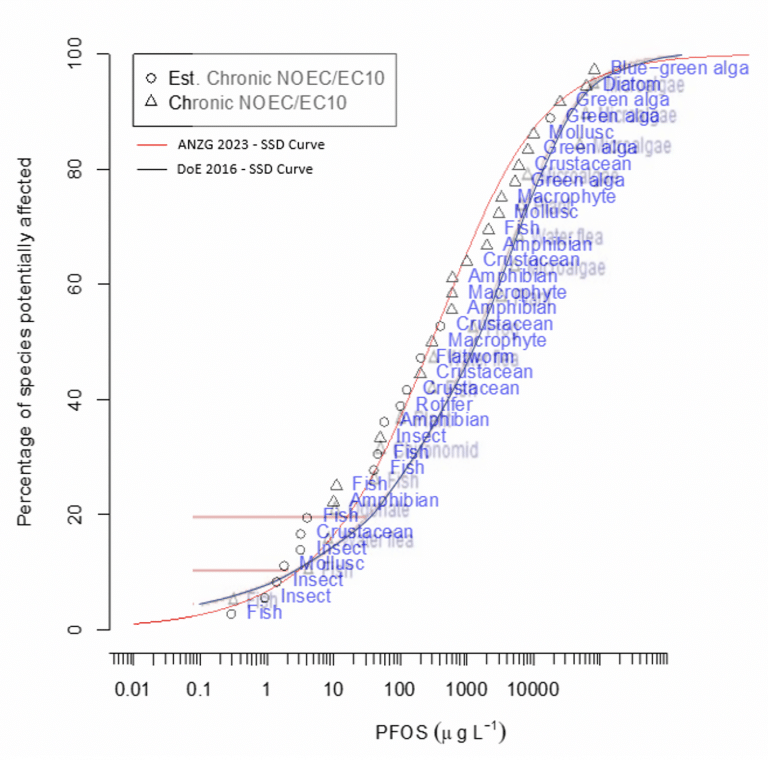Potential impact of changes to the default guideline values for Perfluorooctane sulfonate (PFOS) issued by Australia and New Zealand Guidelines for Fresh and Marine Water Quality (May 2023)
Dr Matthew Askeland and Andrew Mitchell
It is well presented in literature that PFOS, once released, can disperse through various pathways such as air, surface water, groundwater, and the food chain. Once in the environment, uptake by biota and bioaccumulation presents a significant environmental risk. However, the bioaccumulation of PFOS is challenging to predict, studies have shown that higher trophic level organisms, including fish and fish-eating organisms, exhibit higher PFOS accumulation. Additionally, air-breathing organisms tend to have higher concentrations of PFOS than their food, indicating bioaccumulation and biomagnification.
The Joint Steering Committee responsible for the revision developed default guideline values (DGVs) for PFOS in freshwater in 2016 and reported these as interim guideline values in HEPA’s PFAS NEMP 2.0 (2020). In October 2018, a revised method for deriving Australian and New Zealand Water Quality Guideline Values (DGVs) for toxicants was issued and has led to this update of the 2016 draft DGVs for PFOS. The updated draft DGVs were subjected to peer review by three experts and the Water Quality Guidelines Technical Manager. Feedback from the review process was addressed, and a new literature review was conducted to identify relevant aquatic toxicity data that may not have been originally considered.
The new DGVs for PFOS in freshwater were derived according to the methodology described in Warne et al. (2018). The derivation of the DGVs followed the approved method, which involved using all acceptable chronic toxicity data. This approach incorporated a dataset of 35 species (see Figure 1), compared to the 18 species used for the 2015 draft DGVs. A comparison of the current DGVs and the 2015 draft DGVs can be found in Table 1 below.
The DGVs were derived based on a cumulative frequency distribution (species sensitivity distribution) analysis using the Burrlioz 2.0 software, which provided a good fit to the data. Data included in the study is available in the technical brief Table A1 and included studies with traditional chronic toxicity endpoints (survival, growth, development, and reproduction). Excluded studies included those with non-traditional chronic toxicity endpoints (behavioral effects, endocrine effects, altered gene expression, and changes to community structure).

The toxicity value dataset spanned over five orders of magnitude and comprised a mix of single species single generation studies, single species multigenerational studies, as well as microcosm and mesocosm studies. In terms of sensitivity to PFOS, fish and invertebrates were generally more sensitive than plants and algae. The zebrafish (Danio rerio) exhibited the highest sensitivity with a LOEC (lowest observed effect concentration) of approximately 0.7 µg/L, while the diatom (Navicula pelliculosa) was the least sensitive species with an EC50 (half maximal effective concentration) of 263,000 µg/L.
It is important to note that the DGVs do not consider the bioaccumulation of PFOS in aquatic food chains. ANZG (2018) advises using the 99% species protection DGV for bioaccumulative toxicants like PFOS in slightly-to-moderately disturbed ecosystems. Further, it is important to consider that while the 99% DGV provides a level of protection, biota in the water may still have elevated tissue concentrations of PFOS. This is relevant for organisms higher in the food chain that consume PFAS impacted biota.

Figure 1. Calculated species sensitivity distribution (SSD) versus relevant concentration of the PFOS anion, 2016 versus 2023 graphical representations superimposed.
There are several limitations to consider regarding the derived guideline values (DGVs) for PFOS:
- Chemical Isomers: The tests assumed that both linear and branched isomers of PFAS were included. However, the specific effects of different isomers on toxicity are not fully understood.
- Plant Uptake: The understanding of PFOS uptake and bioaccumulation by plants is limited, and its implications for toxicity and biomagnification are not well understood.
- Factors Affecting PFOS Toxicity: Limited studies were available on the factors influencing PFOS uptake and toxicity these may vary under relevant environmental conditions (ie. salinity, pH).
- Mixtures and precursors: Synergistic or antagonistic effects with other PFAS congeners were not considered, and PFAS precursor species transformation has not been included.
- Air-Breathing Animals: The DGVs are not intended to specify species protection concentrations for air-breathing animals that live in aquatic ecosystems or prey on aquatic organisms.
- Biota tested: Data used for deriving DGVs namely include species that are not native to Australia as such the applicability of the data to the Australian environment may be impacted.
The recent changes in DVGs for PFOS indicate a decrease in the 80% species protection level. However, the more significant change is in the 99% species protection level for PFOS, which is more frequently applied due to the bioaccumulative nature of PFOS. Here an increase of 36 times from the previous value of 0.00023 µg/L to 0.0091 µg/L was included in the update DGV.
The 2015 DGV was widely recognized globally as being highly conservative and difficult to achieve in the environment as background concentrations of diffuse PFOS contamination in many urban and peri-urban areas of Australia often exceeded this value. The 2015 DVG resulted in most tested environments exceeding the conservative value and as such resulted in most activities constituting risk. The updated DGV is a significantly more useful diagnostic tool, as it more clearly differentiates between likely and unlikely risks, thus greatly improving our ability to distinguish risks from background contamination and then prioritize risk management. While the changes in the DGVs for PFOS may in many regards be welcomed and considered more practical, they have several potential impacts:
- Water Discharge Licensing: The revised DGVs, which allow higher PFOS concentrations, may lead to changes in future water discharge licensing conditions. Regulatory authorities responsible for issuing licenses may consider adjusting the permissible PFOS concentrations in wastewater discharges based on the new DGVs and consideration of the concentration of PFOS at the discharge points mixing zone (background PFOS concentrations and dilution factors).
- Retrospective Changes to Existing Licensing and Permitting Conditions: The more stringent water treatment or management conditions previously based on the lower PFOS value of 0.23 ng/L may need to be re-evaluated. Existing licenses or permits that were issued based on the previous guidelines may undergo retrospective changes to align with the revised DGVs (i.e., landfill and treatment licences/permits).
- Soil Leachate and Environmental Risk: The higher DGVs for PFOS could also impact soil leachate concentration guidelines and the assessment of environmental risk to aquatic ecosystems by means of PFAS leaching from soils. To exemplify this, using the Rule of 20, where the ASLP method ultimately allows for a 20 times dilution of PFAS mass in a solid sample, and assuming a 100% leachability (worst case scenario), a back calculation to total concentration in the solid fraction can be used to demonstrate how the DGVs raise the allowable PFOS concentrations in soil. The outcome demonstrates that leaching above the DGV for 99% species protection (the most sensitive water criteria) can only be achieved by PFOS total concentrations above 0.18 µg/kg compared to the 2015 DGV which resulted in a 0.0046 µg/kg maximum. This has significant implications for soil reuse, as it means that (not withstanding precursors) soil leachate from soils below 1.8 µg/kg are unlikely to present a risk to sensitive aquatic systems.
- Re-evaluation of Contaminated Sites: The re-evaluation of contaminated sites may be necessary, especially where runoff, leachates, or groundwater flows to the environment were previously considered harmful based on the 2015 DGVs. The revised DGVs may result in a different assessment of the risk posed by the mass of PFOS reaching receiving environments.
- Regulatory Review and policy update: Regulatory authorities responsible for water management and environmental protection may review the revised DGVs and assess their implications. They may evaluate the scientific basis, consider stakeholder input, and determine how the new DGVs align with existing regulations and policies. Based on the regulatory review, policies and guidelines related to PFOS and other PFAS contaminants may be updated. This could involve revising water quality standards, discharge limits, remediation targets, and risk assessment methodologies to reflect the revised DGVs.
- Other Potential Impacts: Some other possible impacts could include changes in remediation strategies, environmental monitoring programs, risk assessments for specific ecosystems or species, and the need for updated regulations or state and territory guidelines regarding PFOS.
It is important to note that the specific impacts will depend on the regulatory context, the sensitivity of the ecosystems involved, and the interpretation and adoption of the revised DGVs by relevant authorities.
Overall, the revision of DGVs for PFOS can have significant implications for water management, environmental protection, and regulatory decision-making surrounding contaminated sites and PFAS impacted spoil reuse. The changes in DGVs may lead to adjustments in existing policy and licenses as well as impact future guidelines and license conditions. Additionally, the reevaluation of contaminated sites and the potential impacts on runoff, leachates, and groundwater flows to the environment may be necessary to address scenarios where PFAS management may now be disproportionate to risk.
Ultimately, the revision of DGVs for PFOS is a positive step in balancing environmental protection with the latest scientific understanding and practical considerations. The new value will be a more useful tool in identifying where risk is present, and attention should be focused with respects to managing PFOS. However, the revision of DGVs also highlights the need for ongoing research, knowledge development, and exploration of techniques to quantify the risks associated with PFOS to broaden our understanding of PFAS toxicity. A broader focus on a range of PFAS species is needed, considering that PFOS, while predominant in many cases, is seldom the only PFAS species present. This is evident in recent literature related to PFAS in consumer products, soils, biosolids, recycled water, recycled organics, landfill leachates, and various effluents. There is much work to do develop a better holistic understanding of PFAS prevalence, environmental behavior, uptake, toxicity, and interactions from an environmental and toxicological standpoint.
Also see: release by ANZG in May 2023

Note: the PFOS DVGs are not designed to consider air breathing mammals in aquatic ecosystems and did not incorporate data for Australia’s unique organisms.





